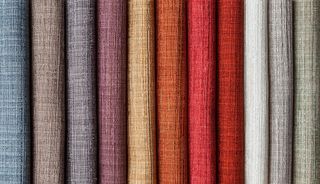Quality Fabric Choices in Charleston, SC
Fabrics can affect the room by bringing out the appearance softness, texture, color and pattern. Fabric is both functional and versatile and be used on window treatments, furniture and accessories (like throw pillows). Fabric can be draped, folded, sewn, stapled, stretched and tucked to create countless accents and accessories for room decor. Choosing the right fabric can be confusing. We have a list of fabric sorted by design characteristics and function.
Identifying fabric is important because it allows us to be able to compare the qualities between different fabrics. More important is the comparison of fabrics. Below is a list of information about different types of fabrics. The information will give you a better understanding about the different the weaves of the fabric and how the weaves affect fabric characteristics and uses.
- Acetate - a manmade fabric that resembles silk.
- Antique Satin - a satin with horizontal (weft) slubs which imitates spun shantung silk. It is 60% rayon (the face yarn fiber) and the 40% of acetate (the back yarn fiber). Often the warp and weft yarns are dyed with different colors to give an iridescent effect.
- Bark Cloth - a coarsely woven fabric often printed with vintage designs
- Batik - is a dyeing method where the cloth is covered with wax designs. It is dipped into vegetable dye that dyes the uncovered cloth without melting the wax. The wax is removed with hot water after the design is finished.
- Brocade - a multi-use formal, Jacquard woven fabric with intricate raised woven designs resembling embroidery. It is often made with variety of thread colors depicting complex patterns and scenes with a shiny finish. Background weave is often satin. To the back of the fabric, the threads are not tied-down and are carried as "floaters".
- Brocatelle - a specific type of medium weight brocade utilizing four or more sets of threads, equally for warp and weft. It has large patterns in high relief to appear embroidered or puffy. It is woven finely for formal, refined and sophisticated wear.
- Burlap - a rough fabric loosely woven from jute or hemp
- Calico - similar to broadcloth, made of cotton or cotton/polyester and usually printed in small "country" all-over with multi-colored floral patterns.
- Canvas - medium to heavy weight cotton fabric woven closely in plain or twill with relatively large threads. Available in variety of colors, stripes and few printed designs. It is also referred as "duck" or "sailcloth". It has many uses.
- Casement - a fabric for drapery either loose or tight, open or closed, plain or novelty weave. Given color, pattern and interesting texture through tied complex-yarn arrangements and variations in weave. Usually it is semi-sheer, translucent or opaque.
- Cashmere - a soft fabric made of the wool grown beneath the outer hair of the Cashmere goat in Tibet and the Kashmir province in India. It is popular because of its softness.
- Chambray - made of cotton or linen, a lightweight fabric in plain, balanced weave using white threads across a colored wrap. Pronounced "sham-bray".
- Chevron - a regular and repeated zigzag pattern formed by reversing the twill weave. It is also known as herringbone.
- Crepe - a light soft thin fabric with a crinkled surface. It is made from silk, cotton, wool, or another fiber either in plain or satin weave.
- Damask - a formal satin base Jacquard fabric of linen, cotton, silk, or wool with reversible patterns. It is medium weight with variety in colors and patterns. Used in decorative fabric situation.
- Denim - a coarse twilled cloth, usually of cotton or cotton/polyester that is practical and sturdy. The navy is used as jeans fabric and cream or white is used as Drill.
- Dupioni - a slubbed silk fabric.
- Embroidery - a surface ornamentation made with a thread or set of threads sewn onto a fabric.
- Eyelet is cotton embroidered with a pattern around open cutouts.
- Finish - a substance or the mixture of substances added to textile materials to impart the desired properties.
- Flannel - a fabric woven and then brushed to achieve a soft nap. It is made of wool or a blend of wool and cotton or synthetics.
- Flock - a material obtained by cutting or grinding textile fibers to fragments. There are two types of flock, precision cut flock, all fiber lengths are approximately equal and random cut flock, the fibers are ground or chopped to produce a broad range of lengths.
- Flocking - a method of ornamenting cloth with adhesive printed or coated on a fabric. Finely chopped fibers are applied by dusting, air-blasting or electrostatic attraction. The fibers adhere to the printed areas and it is removed manually from the unprinted areas.
- Gingham fabric - printed or woven with a single color checked design.
- Herringbone - a regular zigzag pattern fabric with a novelty or complex twill weave. It is woven or printed on lightweight to heavyweight fabrics.
- Houndstooth - a medium- to heavy-weight woven twill fabric designed with continuous broken checks or four-pointed stars resembling projecting "tooth-like" corners.
- Jacquard - a weaving system that utilizes a versatile pattern mechanism to permit the production of large and intricate patterns.
- Lisserie - a fine Jacquard woven stripe that imitates silk and embroidery. The different figures and colors in the pattern comes from the warp.
- Linen - made from flax and prone to wrinkling.
- Matelassé - a heavyweight upholstery textile in Jacquard weave with double sets of warps and wefts. The surface appears to be puffy or cushioned and is also known as double cloth.
- Mohair - a fabric obtained from yarn made from the silky hair of the Angora goat.
- Moire - a formal fabric also known as water marked silk
- Muslin - an inexpensive cotton fabric that is light tan in color.
- Nylon - a manmade fiber where the forming substance is a synthetic polyamide. It exhibits excellent strength, flexibility, elasticity and abrasion resistance.
- Ottoman - a heavy silk or rayon fabric with broad, round weft threads that produce a horizontal rib. Used for coats and trimmings.
- Paisley - a design featuring a pattern of scrolled teardrop shapes.
- Peau de Soie - a soft and fine silk fabric of satin weave having ribbed or grained appearance. It is a French term that literally means "skin of silk".
- Pile fabric - a fabric with an extra warp or weft set, woven to produce a deep surface texture like velvet, terry cloth, frieze or corduroy.
- Pilling - fibers tendency to work loose from the fabric surface and form a balled or matted particles attached to the surface of the fabric.
- Plaid - a cloth having a crisscross design. The stripes in warp and weft directions cross at intervals to form different colors in square or rectangular patterns. It may be plain or twill weave.
- Plisse' - a blistered or puckered finish given to a sheer, thin or lightweight fabric with a caustic soda.
- Polyester - a manmade fiber where the forming substance is any synthetic polymer. It has high strength and are resistant to shrinking and stretching. It is also wrinkle resistant.
- Rayon - a manmade fiber composed of regenerated cellulose.
- Rep, Repp - rib woven fabric (horizontal or vertical ribs) between poplin and ottoman in rib size and weight. It is durable and medium to heavyweight. Woven from cotton, wool, or silk.
- Satin - a basic type of weave with up to eight weft threads tied down with one floating weft thread. It is light to medium-weight with glossy face and a dull back.
- Scrim - a durable, open weave sheer cotton fabric used for curtains or upholstery lining or in industry.
- Shantung dupioni - originally a spun silk fabric with slubs and forms interesting textures. Today, shantung may be of natural or synthetic fibers. Fabrics imitating shantung are antique satin and antique taffeta.
- Silk is pricey and best known for brilliant color and luster
- Strie is a finely striped pattern that resembles a comb painting.
- Suede cloth - a light or medium-weight synthetic knit or woven textile with brushed nap imitating suede leather.
- Tapestry - a Jacquard woven with multiple warps and wefts creating various color patterns or scenes. Used as wall hangings for decoration or sometimes to cover furniture.
- Ticking - a heavy striped cotton fabric used for mattress upholstery.
- Toile - a sheer fabric similar to muslin or percale in plain or twill weave obtained from cotton or linen.
- Tufted fabric - a pile fabric formed by tufting a yarn into a woven background. Example, some upholstery fabrics and all tufted carpets.
- Tweed - a coarse, rugged, and often nubby woolen fabric in plain balanced or variation (originally twill) weave. Used as casual suits and coats.
- Velour - a closely napped fabric with a soft, velvet-like texture, used for clothing and upholstery. It includes some velvet, and all plush-pile surface cloths.
- Velvet - a pile woven cotton, silk, and/or rayon fabric with a soft yet sturdy face. Very much like plush but with a shorter pile. The underside is plain.
- Vinyl - extruded polyvinyl chloride synthetic fabric flowed onto a knitted, woven, or non-woven base cloth imitating leather. It is medium to heavyweight upholstery fabric.
- Voile - a light, plain weave, sheer transparent fabric with tightly twisted yarns often having a stiff finish. Available in novelty effects like pique stripes, printed patterns and stripes. It is obtained from cotton, rayon, silk, or wool and used especially for making dresses and curtains.
Contact Information
Business Hours
- Mon - Fri
- -
- Sat - Sun
- Closed






